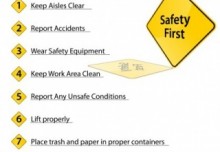 Risk Prevention – OSHA Top 10 Violations 2014
Risk Prevention – OSHA Top 10 Violations 2014
The following were the top 10 most frequently cited standards by Federal OSHA in fiscal year 2014 (October 1, 2013 through September 30, 2014). Most of these violations are similar to the ones for previous years, therefore there is a good chance your company could be in violation. Here we provide some examples of what to look for in order for you and your company to stay ahead of the most cited violations and when you remediate the negative findings you will squash potential violations and incidents before they happen.
10. Electrical systems design, general requirements, general industry (29 CFR 1910.303), 2427 Total violations
Examine the following:
- Electric equipment and cabinetry
- Make sure electrical equipment is housed according to manufacturer specification
- Make sure there is proper space around electrical equipment as per manufacturer specification and that electrical is never blocked in case a quick disconnect is needed
- When changes and/or additions are made, ensure existing electrical equipment housing can properly accommodate those additions/changes
- Make sure everything is identified, installed properly, and is being used properly
- Along with regular circuitry and switches, specifically identify and account for all devices such as pressure terminals, pressure splicing connectors and soldering lugs
- Electrical equipment identification of manufacturer and ratings
- Make sure equipment is labeled or tagged with manufacturer, ratings, and proper use information
- Electrical disconnecting
- Be certain electrical circuits are well documented and that training is provided for circuit operations
- Be certain disconnect procedures are documented and frequent training is held for each of the procedures
9. Machinery and Machine Guarding, general requirements (29 CFR 1910.212), 2520 Total violations
Examine the following:
- Types of guarding
- Ensure the guarding in place is effective, there are occasions where the guarding provided by the manufacturer is not adequate for your application. In most cases all exposed moving parts must be guarded
- Be certain to guard against exposed blades. Different blades have different guards and different guarding requirements, make sure you understand and comply with exposed blade guarding
- Guard the point of operation
- Ensure guarding protects employees from the point(s) of operation
- Ensure guarding is not removed by employees, often employees find guarding “in the way”. When this happens, work with the employees to remedy whatever is “in the way” and stress the importance of guarding
- Anchor fixed machinery
- Ensure machinery is properly anchored to the floor or ground as per manufacturer specification and specific to your conditions (type of floor, surface, etc.)
- Check anchors periodically as vibration tends to loosen anchors
8. Electrical, wiring methods, components and equipment, general industry (29 CFR 1910.305), 2907 Total violations
Examine the following:
- Flexible cords and cables
- Ensure your flexible cords and cables are approved for conditions standard interpretation
- Do not have flexible cords and cables running through doors or windows
- Cutout boxes, cabinets and fittings
- Be sure knock outs and openings in the electrical boxes are closed for protection from the elements and possible damage
- Ensure that proper connectors are used when cords pass through boxes and cabinets so the cords are protected from abrasion and damage
- Grounding conductors
- Be sure metal race ways, cable trays, cable armor, cable sheaths, enclosures, frames, fittings and any other metal serving as ground are effectively bonded
- Exposed wires and/or connectors
- Remediate any exposed electrical components for all fixtures, lamp holders, lamps, rosettes and receptacles
7. Ladders, construction (29 CFR 1926.1053), 2967 Total violations
Note and comply with the following:
- Ladder use
- Read and follow the ladder instructions for intended use and weight restrictions
- Frame ladder top is NEVER a step
- Straight ladders must extend at least 3 rungs above the landing to ensure proper stability
- Withdraw defective ladders from service, secure them and place a “DO NOT USE” note on the ladder
- Ladders must only be used on stable, level surfaces unless secured to prevent displacement
6. Lockout/Tagout or control of hazardous energy, general industry (29 CFR 1910.147), 3117 Total violations
Note and comply with the following:
- Lockout/Tagout duties
- Understand the scope, application and purpose of hazardous energy control
- Identify equipment that must have its hazardous components isolated and locked while being worked on or fixed. An example would be a chemical pump’s electric motor would need to be isolated and locked while works is being done
- Establish and train and retrain employees on lockout/tagout procedures and ensure procedures include inspecting the work area once the lock is removed but BEFORE operation resumes to ensure the machine or equipment components are operationally intact
- Apply and enforce lockout/tagout controls
5. Powered industrial trucks, general industry (29 CFR 1910.178), 3147 Total violations
Examine the following:
- Industrial truck operation
- Ensure competency of powered industrial truck operators through training and testing
- Ensure employees perform a pre-shift inspection of powered vehicles and make sure they understand what automatically takes a vehicle out of service such as faulty tire, faulty seat belt operation, and horn inoperable
- Be certain you have and everyone knows the procedures for taking a vehicle that is not in safe operating condition out of service until repaired
- Make sure everyone knows vehicles must not be driven up to anyone standing in front of a bench or other fixed object
4. Respiratory protection, general industry (29 CFR 1910.134), 3843 Total violations
Note and comply with the following:
- Respiratory protection planning
- Establish, document and implement a respiratory protection program
- Ensure proper selection of respirators with appropriate filtering
- Ensure employees complete a medical evaluation by a licensed health care provider for respirator usage and fit testing
- Be sure employees are fit tested for the respirator they will be using
- Be certain everyone is properly trained, know how to use and use their specific respirators
- Know that when employees voluntarily use a respirator, the employer is responsible for respirator use
3. Scaffolding, general requirements, construction (29 CFR 1926.451), 4968 Total violations
Examine and comply with the following:
- Scaffolding use
- Know your scaffold capacities and do not exceed capacity
- Know the criteria for supporting scaffolds and abide support measures
- Scaffolding requires full guardrails or additional personal fall protection systems
- Be aware of specific access requirements and measures like ladder gates
- Make sure platform is fully planked or decked between front uprights and guardrail supports
2. Hazard communication standard, general industry (29 CFR 1910.1200), 6148 Total violations
Examine and comply with the following:
- Hazard communication or HAZCOM
- Develop, implement and maintain a well-documented hazard communication program
- Develop and consistently maintain Safety Data Sheets (SDS)
- Hazard communication training must be conducted annually including Safety Data Sheet (SDS) review
- Be sure to follow the new elements of SDS enforcement which began Dec. 1 2013
- Label everything and do not allow chemicals to be stored or transported in drinking bottles
1. Fall protection, construction (29 CFR 1926.501), 7516 Total violations
Examine and comply with the following:
- Fall protection saves lives and injuries
- Research which system is appropriate for a given situations, with so many options there is no reason not to have proper fall protection
- Properly construct and install fall protection systems
- Make certain employees understand how to use the fall protection provided
- Remember, fall protection is for heights over 6 feet (for construction) or 4 feet (for general industry), roofs, trucks, tankers, or hole hazards
These violations are a direct reflection of the employers’ lack of knowledge and/or lack of concern for their employees. Don’t be an employer with violations. The large monetary and emotional expense of hurting or losing someone is infinitely greater than the small amount of time and money it takes to protect people.













